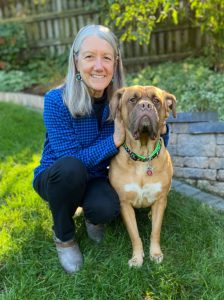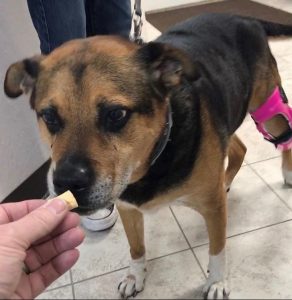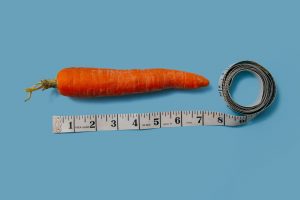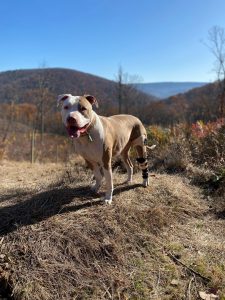
Terry Lackmeyer
Customer Service Representative
Obesity is a national problem in our country. Since pets tend to mirror their owners, obesity, unfortunately, is a national problem among our pets, too. Just as obesity causes health problems in humans, it causes health issues with our pets as well. Our pets suffer from heart disease, joint issues, pancreatitis, diabetes, auto-immune diseases, and cancer. All of which are more common in overweight pets than those maintained at a healthy weight. Thinner dogs live longer lives than their heavier friends and develop less serious diseases later in life. So, if your pet is overweight, it is in their best interest to shed those extra pounds!
Many pet owners are unable to determine if their pet is a healthy weight. In fact, most owners would think a pet of healthy weight is underweight. Sad, but true. Your pet is considered a healthy weight if you can slide your hands down their sides and feel their ribs, with little or no pressure. If you need to press your hands to feel the ribs, they need to lose a few pounds. Your pet should have a waist, a tuck up just behind the ribs. There should be no rolls of fat at the base of the tail, or “muffin top” at the top of their thighs. If those exist, they need to lose weight!
Healthy Diet For Dogs
Now that you have determined your dog needs a diet, how do you proceed? First off, no crash diets. Those are bad for humans, and they are bad for pets. The best way to have your pet lose weight and to keep it off, is to lose the weight slowly. First, determine how much your pet is eating. If you are following the guidelines on the dog food bag or can, keep in mind that those guidelines are for non-neutered and non-spayed male and female dogs who live an active lifestyle – not the circumstances for most pets. So, if you are feeding what they recommend, you probably are feeding too much. Reduce what you are feeding by about 5% and accurately measure the amount you are feeding. Eyeballing the amount of food being fed is a good way to overfeed your dog.
Healthy dog food is high in protein and low in carbohydrates. Most pet owners feed kibble which is a good food source for pets. However, manufacturers tend to use carbohydrates as a binding agent in the food. While this improves the nutrition, it also increases the calories and tends to make pets gain weight. Look for a higher protein food source. This also will tend to keep your dog feeling fuller, longer. Remember, dogs are carnivores by nature which means there are not a lot of carbohydrates in that diet. Be sure to check with your veterinarian for recommendations as well as their input before switching to a higher protein diet as some pets have health conditions that would not respond well to high protein diets.
Treats For Weight Loss
Keep in mind, too, that pets have no comprehension of how much they are getting. Take that treat and break it into tiny pieces. One treat can go a long way when you do that, and your pet will think they are getting lots of treats when they are only getting one.
Treats do not need to be store bought. Cutting up various vegetables, such as carrots, green beans, and cucumbers, or fruits like apples or bananas are excellent treats with no added fat or sugar. Remember, you don’t want to feed the entire carrot, apple, or banana. Cut them up into tiny pieces. Another great treat is ice chips. Most dogs love them, and they don’t have any calories at all! Remember, dogs have no concept of how much they are getting, they just want something, so very tiny pieces are perfect.
Using interactive toys is a great way to get you dog moving while working for their treat. Toys that allow you to hide treats inside them get the dog to move about and play while “working” for those tidbits. Again, don’t forget to include these treats in the daily calorie count.
It is important to monitor all the food your dog is consuming. Be sure everyone in the house understands how important it is that your dog sheds that excess weight. If your partner or children are sneaking treats to Rover throughout the day, it will sabotage your best efforts. Even letting your dog lick your plate after dinner or in the dishwasher as you fill it adds calories. Many sauces left on the plate for your dog to lick are loaded with calories – think bar-b-que and cream sauces.
Benefits of Exercise
Rewards for your dog do not always need to be food. Most dogs thrive on interaction with their humans. Belly rubs and head scratches make great rewards. Throwing a toy or ball makes an equally rewarding treat and adds exercise.
Exercise is a vital part of helping your dog to lose weight. For most dogs – strive for a minimum of 30 minutes of exercise daily. Thirty minutes of exercise does not necessarily mean 30 minutes all at one time. You can try walking your dog just 10 minutes at a time, provided it adds up to thirty minutes at the end of the day.
In fact, if your dog is really heavy this may be the best approach. Depending on how heavy your dog is, they may need to gradually move into the exercise routine. When exercising your dog, be sure to consider not only the weight they need to lose, but also their age. An older dog who has lived a sedentary life is not going to be able to jump into a strenuous exercise routine, nor should they. Remember the adage, “Slow and steady wins the race.”
Exercise isn’t just walking. Try throwing the ball for your dog or playing tug of war. Anything that gets them moving and gets their heart going is good. Consider the work your dog was bred to perform and try to engage them in more instinctive exercise – swimming for Labradors and golden retrievers, tracking for hunting dogs. Remember, the exercise is not just good for your dog, it is beneficial for you, too!
Progress & Results
Dogs are like people in that different breeds lose weight at different rates. If you are following these guidelines, you should see your dog slowly losing weight. For a 50-pound dog, a weight loss of about 2 pounds per month is an acceptable rate. Weight loss for dogs that happens too quickly could cause the muscles to shrink and your dog to be ravenous.
If you have been religious about monitoring your dog’s food intake and seeing that your dog gets ample exercise and your dog is not losing weight, it’s time to consult with your vet again. Certain hormonal conditions such as Cushing’s disease and hypothyroidism can make it especially difficult for your dog to lose weight. Your vet can test for these conditions, and if discovered, they can be treated with medications.
Following these weight loss tips for dogs will help your pup shed some pounds and maintain their new figure. Keeping your dog at a healthy weight will help them to live a longer life and will certainly make for a happier life for both of you.


